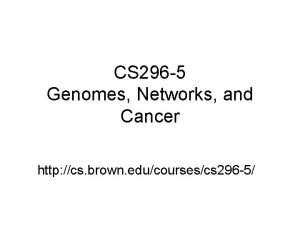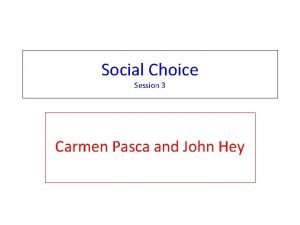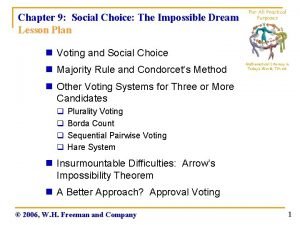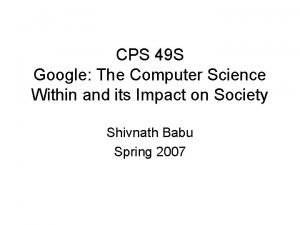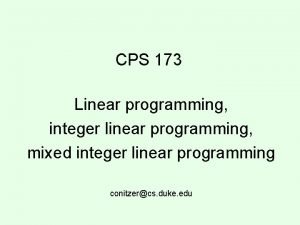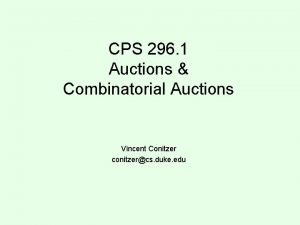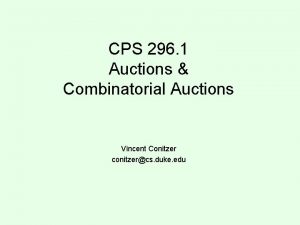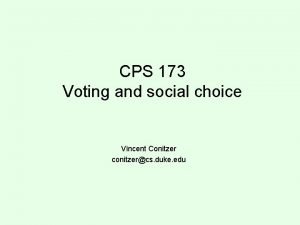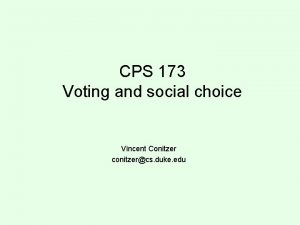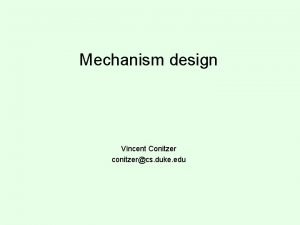CPS 296 3 Social Choice Mechanism Design Vincent














![Arrow’s impossibility theorem [1951] • Suppose there at least 3 candidates • Then there Arrow’s impossibility theorem [1951] • Suppose there at least 3 candidates • Then there](https://slidetodoc.com/presentation_image_h2/d4d700e6bc1de86cd425d02bb22f33d4/image-15.jpg)
![Muller-Satterthwaite impossibility theorem [1977] • Suppose there at least 3 candidates • Then there Muller-Satterthwaite impossibility theorem [1977] • Suppose there at least 3 candidates • Then there](https://slidetodoc.com/presentation_image_h2/d4d700e6bc1de86cd425d02bb22f33d4/image-16.jpg)
















![The Clarke (aka. VCG) mechanism [Clarke 71] • The Clarke mechanism chooses some outcome The Clarke (aka. VCG) mechanism [Clarke 71] • The Clarke mechanism chooses some outcome](https://slidetodoc.com/presentation_image_h2/d4d700e6bc1de86cd425d02bb22f33d4/image-33.jpg)






- Slides: 39

CPS 296. 3 Social Choice & Mechanism Design Vincent Conitzer conitzer@cs. duke. edu

Voting over outcomes > > voting rule (mechanism) determines winner based on votes

Voting (rank aggregation) • Set of m candidates (aka. alternatives, outcomes) • n voters; each voter ranks all the candidates – E. g. if set of candidates {a, b, c, d}, one possible vote is b > a > d > c – Submitted ranking is called a vote • A voting rule takes as input a vector of votes (submitted by the voters), and as output produces either: – the winning candidate, or – an aggregate ranking of all candidates • Can vote over just about anything – political representatives, award nominees, where to go for dinner tonight, joint plans, allocations of tasks/resources, … – Also can consider other applications: e. g. aggregating search engine’s rankings into a single ranking

Example voting rules • Scoring rules are defined by a vector (a 1, a 2, …, am); being ranked ith in a vote gives the candidate ai points – Plurality is defined by (1, 0, 0, …, 0) (winner is candidate that is ranked first most often) – Veto (or anti-plurality) is defined by (1, 1, …, 1, 0) (winner is candidate that is ranked last the least often) – Borda is defined by (m-1, m-2, …, 0) • Plurality with (2 -candidate) runoff: top two candidates in terms of plurality score proceed to runoff; whichever is ranked higher than the other by more voters, wins • Single Transferable Vote (STV, aka. Instant Runoff): candidate with lowest plurality score drops out; if you voted for that candidate, your vote transfers to the next (live) candidate on your list; repeat until one candidate remains • Similar runoffs can be defined for rules other than plurality

Pairwise elections two votes prefer Kerry to Bush > > > two votes prefer Kerry to Nader > > > two votes prefer Nader to Bush > > >

Condorcet cycles two votes prefer Bush to Kerry > > > two votes prefer Kerry to Nader > > > two votes prefer Nader to Bush > > > “weird” preferences ?

Voting rules based on pairwise elections • Copeland: candidate gets two points for each pairwise election it wins, one point for each pairwise election it ties • Maximin (aka. Simpson): candidate whose worst pairwise result is the best wins • Slater: create an overall ranking of the candidates that is inconsistent with as few pairwise elections as possible • Cup/pairwise elimination: pair candidates, losers of pairwise elections drop out, repeat

Even more voting rules… • Kemeny: create an overall ranking of the candidates that has as few disagreements as possible with a vote on a pair of candidates • Bucklin: start with k=1 and increase k gradually until some candidate is among the top k candidates in more than half the votes • Approval (not a ranking-based rule): every voter labels each candidate as approved or disapproved, candidate with the most approvals wins • … how do we choose a rule from all of these rules? • How do we know that there does not exist another, “perfect” rule? • Let us look at some criteria that we would like our voting rule to satisfy

Even more voting rules… • Kemeny: create an overall ranking of the candidates that has as few disagreements as possible with a vote on a pair of candidates • Bucklin: start with k=1 and increase k gradually until some candidate is among the top k candidates in more than half the votes • Approval (not a ranking-based rule): every voter labels each candidate as approved or disapproved, candidate with the most approvals wins • … how do we choose a rule from all of these rules? • How do we know that there does not exist another, “perfect” rule? • Let us look at some criteria that we would like our voting rule to satisfy

Condorcet criterion • A candidate is the Condorcet winner if it wins all of its pairwise elections • Does not always exist… • … but if it does exist, it should win • Many rules do not satisfy this • E. g. for plurality: – b>a>c>d – c>a>b>d – d>a>b>c • a is the Condorcet winner, but it does not win under plurality

Majority criterion • If a candidate is ranked first by most votes, that candidate should win • Some rules do not even satisfy this • E. g. Borda: – a>b>c>d>e – c>b>d>e>a • a is the majority winner, but it does not win under Borda

Monotonicity criteria • Informally, monotonicity means that “ranking a candidate higher should help that candidate”, but there are multiple nonequivalent definitions • A weak monotonicity requirement: if – candidate w wins for the current votes, – we then improve the position of w in some of the votes and leave everything else the same, then w should still win. • E. g. STV does not satisfy this: – 7 votes b > c > a – 7 votes a > b > c – 6 votes c > a > b • c drops out first, its votes transfer to a, a wins • But if 2 votes b > c > a change to a > b > c, b drops out first, its 5 votes transfer to c, and c wins

Monotonicity criteria… • A strong monotonicity requirement: if – candidate w wins for the current votes, – we then change the votes in such a way that for each vote, if a candidate c was ranked below w originally, c is still ranked below w in the new vote then w should still win. • Note the other candidates can jump around in the vote, as long as they don’t jump ahead of w • None of our rules satisfy this

Independence of irrelevant alternatives • Independence of irrelevant alternatives criterion: if – the rule ranks a above b for the current votes, – we then change the votes but do not change which is ahead between a and b in each vote then a should still be ranked ahead of b. • None of our rules satisfy this
![Arrows impossibility theorem 1951 Suppose there at least 3 candidates Then there Arrow’s impossibility theorem [1951] • Suppose there at least 3 candidates • Then there](https://slidetodoc.com/presentation_image_h2/d4d700e6bc1de86cd425d02bb22f33d4/image-15.jpg)
Arrow’s impossibility theorem [1951] • Suppose there at least 3 candidates • Then there exists no rule that is simultaneously: – Pareto efficient (if all votes rank a above b, then the rule ranks a above b), – nondictatorial (there does not exist a voter such that the rule simply always copies that voter’s ranking), and – independent of irrelevant alternatives
![MullerSatterthwaite impossibility theorem 1977 Suppose there at least 3 candidates Then there Muller-Satterthwaite impossibility theorem [1977] • Suppose there at least 3 candidates • Then there](https://slidetodoc.com/presentation_image_h2/d4d700e6bc1de86cd425d02bb22f33d4/image-16.jpg)
Muller-Satterthwaite impossibility theorem [1977] • Suppose there at least 3 candidates • Then there exists no rule that simultaneously: – satisfies unanimity (if all votes rank a first, then a should win), – is nondictatorial (there does not exist a voter such that the rule simply always selects that voter’s first candidate as the winner), and – is monotone (in the strong sense).

Manipulability • Sometimes, a voter is better off revealing her preferences insincerely, aka. manipulating • E. g. plurality – Suppose a voter prefers a > b > c – Also suppose she knows that the other votes are • 2 times b > c > a • 2 times c > a > b – Voting truthfully will lead to a tie between b and c – She would be better off voting e. g. b > a > c, guaranteeing b wins • All our rules are (sometimes) manipulable

Gibbard-Satterthwaite impossibility theorem • Suppose there at least 3 candidates • There exists no rule that is simultaneously: – onto (for every candidate, there are some votes that would make that candidate win), – nondictatorial, and – nonmanipulable

Single-peaked preferences • Suppose candidates are ordered on a line • Every voter prefers candidates that are closer to her most preferred candidate • Let every voter report only her most preferred candidate (“peak”) • Choose the median voter’s peak as the winner – This will also be the Condorcet winner • Nonmanipulable! v 5 v 4 a 1 v 2 a 3 v 1 a 4 v 3 a 5

Some computational issues in social choice • Sometimes computing the winner/aggregate ranking is hard – E. g. for Kemeny and Slater rules this is NP-hard • For some rules (e. g. STV), computing a successful manipulation is NP-hard – Manipulation being hard is a good thing (circumventing Gibbard. Satterthwaite? )… But would like something stronger than NP-hardness – Researchers have also studied the complexity of controlling the outcome of an election by influencing the list of candidates/schedule of the Cup rule/etc. • Preference elicitation: – We may not want to force each voter to rank all candidates; – Rather, we can selectively query voters for parts of their ranking, according to some algorithm, to obtain a good aggregate outcome

What is mechanism design? • In mechanism design, we get to design the game (or mechanism) – e. g. the rules of the auction, marketplace, election, … • Goal is to obtain good outcomes when agents behave strategically (game-theoretically) • Mechanism design often considered part of game theory • Sometimes called “inverse game theory” – In game theory the game is given and we have to figure out how to act – In mechanism design we know how we would like the agents to act and have to figure out the game • The mechanism-design part of this course will also consider non-strategic aspects of mechanisms – E. g. computational feasibility

Example: (single-item) auctions • Sealed-bid auction: every bidder submits bid in a sealed envelope • First-price sealed-bid auction: highest bid wins, pays amount of own bid • Second-price sealed-bid auction: highest bid wins, pays amount of second-highest bid 1: $10 bid 2: $5 bid 3: $1 0 first-price: bid 1 wins, pays $10 second-price: bid 1 wins, pays $5

Which auction generates more revenue? • Each bid depends on – bidder’s true valuation for the item (utility = valuation - payment), – bidder’s beliefs over what others will bid (→ game theory), – and. . . the auction mechanism used • In a first-price auction, it does not make sense to bid your true valuation – Even if you win, your utility will be 0… • In a second-price auction, (we will see later that) it always makes sense to bid your true valuation bid 1: $10 a likely outcome for the first-price mechanism bid 1: $5 a likely outcome for the secondprice mechanism bid 2: $4 bid 3: $1 0 bid 2: $5 bid 3: $1 0 Are there other auctions that perform better? How do we know when we have found the best one?

Bayesian games • In a Bayesian game a player’s utility depends on that player’s type as well as the actions taken in the game – Notation: θi is player i’s type, drawn according to some distribution from set of types Θi – Each player knows/learns its own type, not those of the others, before choosing action • Pure strategy si is a mapping from Θi to Ai (where Ai is i’s set of actions) – In general players can also receive signals about other players’ utilities; we will not go into this row player U type 1 (prob. 0. 5) D row player U type 2 (prob. 0. 5) D L R 4 6 2 4 L R 2 4 4 2 column player U type 1 (prob. 0. 5) D column player U type 2 (prob. 0. 5) D L R 4 6 L R 2 2 4 2

Converting Bayesian games to normal form U row player type 1 (prob. 0. 5) D U row player type 2 (prob. 0. 5) D L R 4 6 2 4 L R 2 4 4 2 column player U type 1 (prob. 0. 5) D column player U type 2 (prob. 0. 5) D L R 4 6 L R 2 2 4 2 type 1: L type 1: R type 2: L type 2: R type 1: U type 2: U type 1: U type 2: D type 1: D type 2: U type 1: D type 2: D 3, 3 4, 3. 5 4, 3 4, 4. 5 5, 4 4, 4 exponential blowup in size

Bayes-Nash equilibrium • A profile of strategies is a Bayes-Nash equilibrium if it is a Nash equilibrium for the normal form of the game – Minor caveat: each type should have >0 probability • Alternative definition: for every i, for every type θi, for every alternative action ai, we must have: Σθ-i P(θ-i) ui(θi, σi(θi), σ-i(θ-i)) ≥ Σθ-i P(θ-i) ui(θi, ai, σ-i(θ-i))

Mechanism design: setting • The center has a set of outcomes O that she can choose from – Allocations of tasks/resources, joint plans, … • Each agent i draws a type θi from Θi – usually, but not necessarily, according to some probability distribution • Each agent has a (commonly known) utility function ui: Θi x O → – Note: depends on θi, which is not commonly known • The center has some objective function g: Θ x O → – Θ = Θ 1 x. . . x Θn – E. g. social welfare (Σi ui(θi, o)) – The center does not know the types

What should the center do? • She would like to know the agents’ types to make the best decision • Why not just ask them for their types? • Problem: agents might lie • E. g. an agent that slightly prefers outcome 1 may say that outcome 1 will give him a utility of 1, 000 and everything else will give him a utility of 0, to force the decision in his favor • But maybe, if the center is clever about choosing outcomes and/or requires the agents to make some payments depending on the types they report, the incentive to lie disappears…

Quasilinear utility functions • For the purposes of mechanism design, we will assume that an agent’s utility for – his type being θi, – outcome o being chosen, – and having to pay πi, can be written as ui(θi, o) - πi • Such utility functions are called quasilinear • Some of the results that we will see can be generalized beyond such utility functions, but we will not do so

Definition of a (direct-revelation) mechanism • A deterministic mechanism without payments is a mapping o: Θ → O • A randomized mechanism without payments is a mapping o: Θ → Δ(O) – Δ(O) is the set of all probability distributions over O • Mechanisms with payments additionally specify, for each agent i, a payment function πi : Θ → (specifying the payment that agent must make) • Each mechanism specifies a Bayesian game for the agents, where i’s set of actions Ai = Θi – We would like agents to use the truth-telling strategy defined by s(θi) = θi

Incentive compatibility • Incentive compatibility (aka. truthfulness) = there is never an incentive to lie about one’s type • A mechanism is dominant-strategies incentive compatible (aka. strategy-proof) if for any i, for any type vector θ 1, θ 2, …, θi, …, θn, and for any alternative type θi’, we have ui(θi, o(θ 1, θ 2, …, θi, …, θn)) – πi(θ 1, θ 2, …, θi, …, θn) ≥ ui(θi, o(θ 1, θ 2, …, θi’, …, θn)) – πi(θ 1, θ 2, …, θi’, …, θn) • A mechanism is Bayes-Nash equilibrium (BNE) incentive compatible if telling the truth is a BNE, that is, for any i, for any types θi, θi’, Σθ-i P(θ-i) (ui(θi, o(θ 1, θ 2, …, θi, …, θn)) – πi(θ 1, θ 2, …, θi, …, θn)) ≥ Σθ-i P(θ-i) (ui(θi, o(θ 1, θ 2, …, θi’, …, θn)) – πi(θ 1, θ 2, …, θi’, …, θn))

Individual rationality • A selfish center: “All agents must give me all their money. ” – but the agents would simply not participate – If an agent would not participate, we say that the mechanism is not individually rational • A mechanism is ex-post individually rational if for any i, for any type vector θ 1, θ 2, …, θi, …, θn, we have ui(θi, o(θ 1, θ 2, …, θi, …, θn)) – πi(θ 1, θ 2, …, θi, …, θn) ≥ 0 • A mechanism is ex-interim individually rational if for any i, for any type θi, Σθ-i P(θ-i) (ui(θi, o(θ 1, θ 2, …, θi, …, θn)) – πi(θ 1, θ 2, …, θi, …, θn)) ≥ 0 – i. e. an agent will want to participate given that he is uncertain about others’ types (not used as often)
![The Clarke aka VCG mechanism Clarke 71 The Clarke mechanism chooses some outcome The Clarke (aka. VCG) mechanism [Clarke 71] • The Clarke mechanism chooses some outcome](https://slidetodoc.com/presentation_image_h2/d4d700e6bc1de86cd425d02bb22f33d4/image-33.jpg)
The Clarke (aka. VCG) mechanism [Clarke 71] • The Clarke mechanism chooses some outcome o that maximizes Σi ui(θi’, o) – θi’ = the type that i reports • To determine the payment that agent j must make: – Pretend j does not exist, and choose o-j that maximizes Σi≠j ui(θi’, o-j) – Make j pay Σi≠j (ui(θi’, o-j) - ui(θi’, o)) • We say that each agent pays the externality that he imposes on the other agents • (VCG = Vickrey, Clarke, Groves)

The Clarke mechanism is strategy-proof • Total utility for agent j is uj(θj, o) - Σi≠j (ui(θi’, o-j) - ui(θi’, o)) = uj(θj, o) + Σi≠j ui(θi’, o) - Σi≠j ui(θi’, o-j) • But agent j cannot affect the choice of o-j • Hence, j can focus on maximizing uj(θj, o) + Σi≠j ui(θi’, o) • But mechanism chooses o to maximize Σi ui(θi’, o) • Hence, if θj’ = θj, j’s utility will be maximized! • Extension of idea: add any term to agent j’s payment that does not depend on j’s reported type • This is the family of Groves mechanisms [Groves 73]

Additional nice properties of the Clarke mechanism • Ex-post individually rational, assuming: – An agent’s presence never makes it impossible to choose an outcome that could have been chosen if the agent had not been present, and – No agent ever has a negative utility for an outcome that would be selected if that agent were not present • Weak budget balanced - that is, the sum of the payments is always nonnegative – assuming: – If an agent leaves, this never makes the combined welfare of the other agents (not considering payments) smaller

Clarke mechanism is not perfect • Requires payments + quasilinear utility functions • In general money needs to flow away from the system – Strong budget balance = payments sum to 0 – In general, this is impossible to obtain in addition to the other nice properties [Green & Laffont 77] • Vulnerable to collusion – E. g. suppose two agents both declare a ridiculously large value (say, $1, 000) for some outcome, and 0 for everything else. What will happen? • Maximizes sum of agents’ utilities (if we do not count payments), but sometimes the center is not interested in this – E. g. sometimes the center wants to maximize revenue

Why restrict attention to truthful direct-revelation mechanisms? • Bob has an incredibly complicated mechanism in which agents do not report types, but do all sorts of other strange things • E. g. : Bob: “In my mechanism, first agents 1 and 2 play a round of rock-paper-scissors. If agent 1 wins, she gets to choose the outcome. Otherwise, agents 2, 3 and 4 vote over the other outcomes using the Borda rule. If there is a tie, everyone pays $100, and…” • Bob: “The equilibria of my mechanism produce better results than any truthful direct revelation mechanism. ” • Could Bob be right?

The revelation principle • For any (complex, strange) mechanism that produces certain outcomes under strategic behavior (dominant strategies, BNE)… • … there exists a (dominant-strategies, BNE) incentive compatible direct revelation mechanism that produces the same outcomes! new mechanism P 1 types P 2 P 3 actions mechanism outcome

A few computational issues in mechanism design • Algorithmic mechanism design – Sometimes standard mechanisms are too hard to execute computationally (e. g. Clarke requires computing optimal outcome) – Try to find mechanisms that are easy to execute computationally (and nice in other ways), together with algorithms for executing them • Automated mechanism design – Given the specific setting (agents, outcomes, types, priors over types, …) and the objective, have a computer solve for the best mechanism for this particular setting • When agents have computational limitations, they will not necessarily play in a game-theoretically optimal way – Revelation principle can collapse; need to look at nontruthful mechanisms • Many other things (computing the outcomes in a distributed manner; what if the agents come in over time (online setting); …)
 Good choice or bad choice
Good choice or bad choice Wac 296 305
Wac 296 305 Wac 296-800-160
Wac 296-800-160 Wac 296 305
Wac 296 305 Nnpj-296
Nnpj-296 Executari silite mihai bravu
Executari silite mihai bravu Wac 296-307
Wac 296-307 E 296
E 296 When placing solid web members for beams/columns
When placing solid web members for beams/columns Wac 296-307
Wac 296-307 Cs 296
Cs 296 Social thinking and social influence
Social thinking and social influence Social thinking social influence social relations
Social thinking social influence social relations Lirong xia
Lirong xia Social choice voucher
Social choice voucher Social choice voucher
Social choice voucher Social choice voucher
Social choice voucher Cps algebra exit exam
Cps algebra exit exam Cps in project management
Cps in project management Ipums cps
Ipums cps Cps freshman connection
Cps freshman connection Cps special investigator
Cps special investigator Cps molve
Cps molve Cps変換
Cps変換 Cps 506 ryerson
Cps 506 ryerson Cps506
Cps506 Cps 49
Cps 49 Cps 173
Cps 173 Cps 1s
Cps 1s Cps 173
Cps 173 L3 cps
L3 cps Tatoo cps
Tatoo cps Cps template
Cps template Cps-naid
Cps-naid Cps
Cps Cps nielsen
Cps nielsen Dmr cps software hytera
Dmr cps software hytera Centor cps
Centor cps Cps ops
Cps ops Cps north west
Cps north west










